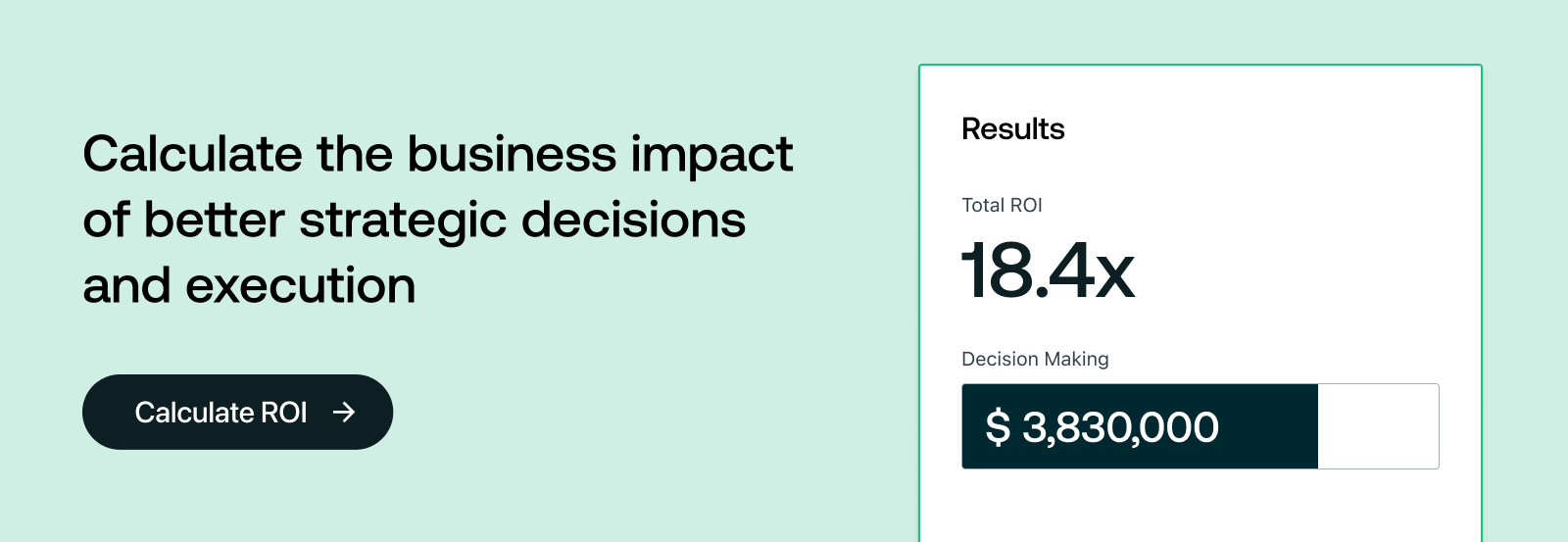Quantive is now part of WorkBoard. Get to know WorkBoard:
You have a solid vision for your business in mind, but your plan isn’t unfolding as smoothly as you’d like. Maybe your team is out of sync with your business’s big picture, different departments are working in silos, or your strategy’s collecting dust, struggling to keep up with recent developments.
Does this sound familiar? If so, you're not alone: 24% of businesses face similar challenges when adjusting their strategy to rapidly changing markets.
The good news? Technology can ease the process, smoothing out the bumps in strategy development. Beyond streamlining the strategic planning process, the right combination of modern technologies, such as a Strategic Intelligence Platform, can keep your strategy up to date and on top of business change continuously.
This article explores the seven common strategy development pitfalls and how Strategic Intelligence Platforms can help you avoid them and realize your strategic plan.

Strategy development pitfall #1: Strategic misalignment
Businesses often have trouble syncing their strategic plan with internal components, such as their vision, values, priorities, and capabilities. This alignment is key to keeping everyone moving in the same direction and toward a shared business goal with strategic initiatives.
Causes and consequences of strategic misalignment
Poor cross-functional collaboration
When teams aren’t communicating as transparently and often as they should, priorities may clash, and the bigger picture gets blurry. Different departments may end up focusing on isolated objectives instead of the broader business strategy.
Top-down approach
If higher-ups and the senior leadership team are the only ones determining the strategic plan, gaps between leadership, employees, and the work being done may emerge. This drives inefficient work, wasting valuable resources.
Weak understanding of business culture and values
Ignoring the business’s culture and values during planning can lead to friction during implementation, causing a clash between strategy and culture. This can drive resistance, hindering buy-in.

Strategy development pitfall #2: Lack of stakeholder buy-in
With only 23% of employees engaged at work, stakeholder engagement, ownership, and adoption emerge as major challenges in strategy development. While strategy is often set at the top, its execution happens at the ground level, so getting everyone on board is just as — if not more — important than the plan itself.
Causes and consequences
Overlooking stakeholder needs
When key stakeholders feel their voices aren’t heard, they may become disengaged or resistant to change, causing significant delays in implementation or half-hearted attempts at executing it.
Lack of regular updates
Without regular updates on strategic progress, challenges, and successes, stakeholder interest and commitment can wane, leading to less ownership and accountability.
Exclusion from planning
Stakeholders who feel left out of the planning process can feel disconnected from the organization, lowering their enthusiasm and motivation when pursuing it.
“Strategy is intensely personality and relationship driven. The way you formulate and go about implementing strategy actually depends on the actors involved more than most people would believe. “
– Roland Pan, Director of Strategy, Skype

Strategy development pitfall #3: Poor integration of strategic insights
According to McKinsey, companies that leverage data are 23 times more likely to outperform competitors in customer acquisition and 19 times more likely to achieve above-average profits. Conversely, when strategic decisions aren’t informed by market data, they often miss the mark completely.
Causes and consequences
Data access issues
Limited access to relevant data or technical barriers can impact timely decision-making. This can make it hard to respond to changing conditions quickly, affecting business adaptability.
Data quality
Relying on outdated, inaccurate, or irrelevant data can steer businesses in the wrong direction, leading to misguided strategies that cause a loss of market share.
Information overload
Excessive data can overwhelm decision-making, leading to rushed, biased choices or delayed responses that result in missed opportunities or reactive strategies.
Cognitive biases
Depending too heavily on assumptions or past experiences can cloud judgment, causing businesses to miss opportunities and adapt to new, changing circumstances.
“31% of respondents pointed out inappropriate influences, personal biases, and individual agendas as the top weaknesses in their organization’s strategy development process.”

Strategy development pitfall #4: Absence of strategic clarity and consistency
Only 40% of employees feel their manager understands the organization's strategy or goals, while only 22% feel they have a clear direction. This lack of clarity on business strategy makes achieving goals a guessing game instead of a clear, actionable plan toward desired outcomes.
Causes and consequences
Inconsistent messaging
Mixed messages from leadership can leave employees feeling lost and unsure of how they contribute to the strategy. This can cause fragmented efforts and execution across departments.
Lack of specificity
Unclear goals without actionable steps make it difficult to track progress, adjust course effectively, and achieve objectives effectively.
Shifting priorities
Frequent, unclear changes in strategic plans can erode trust in leadership, creating doubt about the organization's direction and the competence and vision of leaders.

Strategy development pitfall #5: Poor balance between short-term and long-term initiatives
Juggling short-term goals (e.g., quarterly targets) with long-term aims (e.g., R&D, innovation) can be a challenge. Without careful and intentional merging of the two, businesses may prioritize immediate gains at the expense of long-term value creation — or vice versa.
Causes and consequences
Reactive decision-making
When pressured by short-term demands, businesses might rush decisions and cut corners, compromising the quality and reputation of their offers.
Lack of integrated planning
If short-term and long-term plans aren’t in sync, businesses may miss out on opportunities or forgo necessary long-term investments, impacting business growth as a result.
Annual planning methods
Rigid, traditional planning methods can drive risk aversion, making it harder to grasp short-term opportunities, be responsive, and adjust to market changes.

Strategy development pitfall #6: Treating strategy as a one-time event
Strategy development should evolve with the market instead of being viewed as a one-off event. Treating it as a mere checkbox leads to static or inflexible strategies, leaving business stranded with outdated plans.
Causes and consequences
Leadership disengagement
When leaders aren’t continuously involved in shaping and updating the strategy, they signal that the strategy isn’t a top priority. This can cause a lack of focus, direction, and vision across the organization.
Lack of real-time feedback
Without ongoing feedback loops based on insights from strategy evaluation, businesses may overlook chances to improve strategies based on current data, limiting learning, innovation, and growth prospects.
Resource constraints
Limited resources can prevent regular strategy updates and iterations, leading to a poorly executed strategy that leaves businesses vulnerable to obsolescence.

Strategy development pitfall #7: Disconnect between strategic plan and action
61% of leaders say their businesses struggle to link strategy formulation to day-to-day implementation. Without a concrete action plan, strategy becomes theoretical and disconnected from real-world operations rather than a bridge between a business and its long-term vision.
Causes and consequences
Unclear roles
Role ambiguity blurs the connection between tasks and strategic goals. If employees don’t understand how their work fits into the bigger strategy, they may waste time on initiatives that don’t drive success.
Poor workflow integration
If strategy isn’t integrated into regular workflows properly, employees may continue with outdated, inefficient, or misaligned processes and tasks, impacting productivity and competitiveness.
Limited employee ownership
Employees need a sense of ownership and autonomy to drive progress. Without this, they may lack the motivation to align their work with strategic goals, driving disengagement and poor progress.
“Ensuring a tight linkage between strategy development and how that translates operationally is a challenge. But in effective companies they are integrated in a holistic way ... People should see these steps as part of a continuum.”
— Jeff Austin, DuPont Pioneer

Using Strategic Intelligence Platforms to prevent strategic development pitfalls
Unaddressed, these common pitfalls can snowball across every part of your organization — from day-to-day operations to team morale and performance. To tackle these, you need more than just short-term band-aid. You need a holistic approach.
The right blend of tools can serve as a fully integrated, end-to-end solution that anticipates and neutralizes these challenges before they emerge or escalate.
A Strategic Intelligence Platform maximizes ROI by using data and technology to streamline workflows and automate tasks throughout the strategy management cycle. It supports every stage — development, execution, and evaluation — to keep your strategy measurable, effective, and always on.
Discover the full capabilities of Strategic Intelligence Platforms

With a Strategic Intelligence Platform, you can…
- Collect information and deliver insights: Crunch metrics (e.g., OKRs, KPIs) and market insights (e.g., industry reports, competitive news, consumer trends) to keep what truly matters top-of-mind
- Facilitate cross-functional collaboration: Provide digital collaboration tools to break down departmental silos and drive teamwork
- Integrate stakeholder input: Tap into diverse stakeholder perspectives for buy-in and engagement, making everyone feel involved and engaged with their work
- Monitor and measure progress: Keep stakeholders in the loop with live updates on strategic data, ensuring everyone stays invested
- Simplify strategic adjustments: Anticipate shifts in the business and market landscape with advanced analytics for timely adjustments to your strategy
- Optimize resources: Prioritize and allocate resources based on data-driven insights, maximizing efficiency and impact
- Rapidly create actionable plans: Bridge the gap between strategy and execution with AI-powered insights, ensuring clarity and engagement
- Simulate scenarios: Model potential outcomes to strike the right balance between short-term gains and long-term growth
Calculate the ROI a Strategic Intelligence Platform

Case study: Deutsche Telekom’s success story with Quantive
Deutsche Telekom Services Europe (DTSE) faced strategic roadblocks during the pandemic when remote work disrupted their strategic alignment. They needed a solution connecting everyday work to the company's strategic goals, empowering teams to set their own targets, and creating transparency across the business.
They turned to Objectives and Key Results (OKRs) and Quantive Results software to initiate their strategic plan.
By aligning and evaluating their strategy with Quantive Results, DTSE:
- Navigated its OKR pilot program with management buy-in and trained key players to create a solid strategic foundation
- Mapped out their strategic plan clearly, boosting transparency, knowledge-sharing, and efficiency
- Stayed ahead of industry trends to support them in their transformation from Leading European Telco to Leading Digital Telco
Read the fully story on DTSE’s success with Quantive

Embrace Strategic Intelligence Platforms for resilient planning
Facing challenges during strategy development is inevitable. However, poorly preparing for these can threaten to derail even the most carefully laid out strategic plans.
From missed opportunities to declining performance and loss of competitive edge, the consequences can be severe, potentially rendering your strategy not only ineffective but downright damaging before it’s even put into action.
A Strategic Intelligence Platform enables you to confront these challenges head-on. By driving real-time insights, data-driven decision-making, collaboration, and adaptability, your business can navigate the uncertainties and obstacles of strategic planning with agility, ease, and foresight. As a result, a Strategic Intelligence Platform can keep both your business and its strategy well-positioned for success both now and in the future.
Quantive empowers modern organizations to turn their ambitions into reality through strategic agility. It's where strategy, teams, and data come together to drive effective decision-making, streamline execution, and maximize performance.
As your company navigates today’s competitive landscape, you need an Always-On Strategy to continuously bridge the gap between current and desired business outcomes. Quantive brings together the technology, expertise, and passion to transform your strategy and playbooks from a static formulation to a feedback-driven engine for growth.
Whether you’re a fast-growing scale-up, a mid-market business looking to conquer, or a large enterprise looking for innovation, Quantive keeps you ahead – every step of the way. For more information, visit www.quantive.com.





